Research on Hail Mechanism Features Based on Dual-Polarization Radar Data
Abstract
:1. Introduction
2. Data
- (1)
- The original base data (ZH, ZDR, ρhv) were transformed into three-dimensional uniform grid format data using a bilinear interpolation algorithm;
- (2)
- The composite reflectivity (CR) map was generated from three-dimensional uniform grid reflectivity data using an extremum extraction algorithm [31];
- (3)
- The convective cells were segmented on the CR images using a flood-fill algorithm with 40 dBZ as the threshold [32], resulting in the creation of individual cell masks. Subsequently, other dual-pol data for these cells were obtained.
3. Method
3.1. Mechanism Feature Construction Based on Fine-Grained Cell Data Distribution Details
3.1.1. Gradient-Based Features
3.1.2. Proportion-Based Features in a Specified Value Range
3.1.3. Quantile-Based Intensity Features
3.1.4. Statistical Moment Features Based on the Gray-Level Histogram
3.1.5. Features Based on the Gray-Level Co-occurrence Matrix
3.2. Construction of Traditional Mechanism-Based Features
- (1)
- Kurtosis (K) [24]: Kurtosis is a fourth-order statistical measure based on histogram data from images, used to quantify the steepness of the peak in the histogram. Compared to non-hail cells, hail cells (regions with ZH of 40 dBZ and higher) have a higher proportion of high ZH values. Therefore, typically, the intensity distribution histogram of non-hail cells has a steeper peak;
- (2)
- Average reflectivity of nucleus (ARN) [42]: ARN is defined as the reflectivity-weighted average within contiguous regions on a radar CR image where the ZH exceeds or equals 45 dBZ. A higher ARN indicates a greater likelihood of hail precipitation;
- (3)
- Strong echo ratio (SER) [24]: SER is used to describe the proportion of strong echoes above the −20 °C level and serves as a quantitative measure of the intense echo signals at higher altitudes;
- (4)
- Liquid ratio of nucleus (LRN) [42]: LRN is the feature specifically designed for hail identification on the basis of vertical integrated liquid water content (VIL). As cells pass through the freezing level, precipitation particles gradually transition from a liquid to a solid state (such as ice crystals). The reflectivity values of substances like ice crystals within hail clouds do not conform to their empirical relationship with liquid water. By establishing an attenuation coefficient, LRN attenuates liquid water content converted from the reflectivity, calculating the density of weighted vertical integrated liquid water content. This plays a significant role in distinguishing between hail and short-duration heavy rainfall events;
- (5)
- Effective thickness (ET) [42]: Severe hail-producing weather is more likely to occur with higher and more intense updraft. Effective thickness is a quantitative measure of this phenomenon;
- (6)
- Overhang (OH) [24]: Cells with the potential for hail exhibit an overhanging pattern, where the ZH structure at lower levels displays strong echoes suspended above weaker echo bodies. The presence of low-level moisture-carrying strong updrafts is a primary contributor to the weaker echo regions. Hence, the size of the weaker echo body volume can be used to quantitatively measure the intensity of the updraft, defining overhang in terms of the volume of the weaker echo region;
- (7)
- Volume and Height of ZDR Column
4. Experiment and Analysis
4.1. Feature Validity Assessment
4.1.1. Hypothesis Testing Methods
4.1.2. Hypothesis Testing Results
- (1)
- Among the 564-dimensional features constructed in this study, all 48 features in the gradient category exhibit significant differences;
- (2)
- Among the remaining 516 (564–48) features, 74 features were removed due to excessively high p-values, indicating that these features did not demonstrate a significant difference in mean distribution between hail and non-hail cells.
4.2. Hail Identification Model Construction and Test Metrics
4.2.1. Identification Model
4.2.2. Testing Metrics for Identification Models
4.3. Comparison of Hail Identification Models in Two Mechanism Feature Spaces
4.3.1. Hail Identification Model Based on Traditional Mechanism Features
4.3.2. Hail Identification Model Based on Mechanism Features from Cell Data Distribution Details
- (1)
- Principal Component Analysis (PCA) [50] was used to integrate the 490-dimensional features from five different perspectives. Specifically, from the five sub-feature spaces of gradient, specified value range ratio, quantiles, grayscale histogram statistical moments, and texture based on the GLCM, the directions of maximum variance and second maximum variance were obtained, resulting in a total of 10 comprehensive features (principal components);
- (2)
- Fisher Linear Discriminant Analysis [51] was employed to integrate and reduce the dimensionality of the 490-dimensional features from five different perspectives. In each of the five sub-feature spaces, the projection direction that maximizes the criterion function of difference between inter-class means divided by sum of intra-class variances was determined, resulting in five comprehensive features.
- (1)
- As the dimensionality of PCA comprehensive features increases, classifier performance improves. Furthermore, the use of the 10-dimensional PCA comprehensive feature scheme is more effective than directly building models in the 490-dimensional feature space. This aligns with our expectations and previous research findings [19,20,42];
- (2)
- The Fisher feature comprehensive scheme, overall, outperforms the PCA feature comprehensive scheme. This is because PCA’s “maximum variance criterion” may not necessarily align with the classification objective, while Fisher’s “intra-class cohesion, inter-class separation [52]” criterion aligns with the goals of a classification function. This further substantiates the feasibility of Fisher Linear Discriminant Analysis in hail identification [21,53];
- (3)
- After adopting the Fisher feature comprehensive scheme, the model based on the five-dimensional comprehensive features outperforms the traditional mechanism feature-based identification model. This strongly validates the significant effectiveness of the newly constructed five-dimensional mechanism features in hail identification, further emphasizing that dual-pol radar data can indeed enhance the quality of hail identification models. In the eight-dimensional traditional mechanism feature space, the utilization of dual-pol data is inadequate.
4.3.3. Joint Utilization of Two Types of Mechanism Features for Hail Identification Model Construction
- (1)
- Combining the five-dimensional Fisher-comprehensive features of the second-class mechanism features with the first-class mechanism features (traditional, eight-dimensional) indeed improves the hail identification model’s scores;
- (2)
- Comparing the three models in Table 15, it is evident that among the 13-dimensional features used to describe samples, the 5-dimensional Fisher-comprehensive features play an overwhelmingly dominant role. In terms of the difficulty level of feature extraction, constructing the eight-dimensional traditional feature extraction algorithm is more challenging than the latter. This is because the former requires a deeper understanding of the overall morphology and structure of hail clouds, as well as the ability to summarize and generalize, along with precise algorithmic representation capabilities. In contrast, the latter only needs to internalize the understanding of hail formation mechanisms into determining data height layers, partitioning data value ranges, and setting thresholds. The extraction of micro-gradient operators, specified value range ratios, quantiles, grayscale histogram statistical moments, and texture feature calculation methods based on the GLCM are all generic and convenient. Therefore, its technical threshold is much lower than that of the former. When using the Fisher method to integrate the corresponding sub-feature classes, it is possible to obtain high-quality hail identification models in a lower-dimensional comprehensive feature space.
5. Conclusions
- (1)
- The addition of dual-pol data, specifically ZDR and ρhv, to the hail identification model has led to an improvement of nearly five percentage points in the CSI test results. This demonstrates a clear and significant enhancement in the quality of the hail identification model when utilizing dual-pol data;
- (2)
- In the face of five types of high-dimensional feature spaces, Fisher linear discriminant analysis is used to obtain comprehensive features of each category, and this method of feature construction is proven to be feasible and beneficial. The CSI score of the hail identification model based on 5-dimensional features is 0.65, which is five percentage points higher than that of the model based on 490-dimensional features;
- (3)
- The construction of traditional mechanism features requires algorithm designers to have a profound understanding of the phenomena and essence of the research object and to be able to scientifically incorporate the phenomena and essence of the research object into the algorithms. This approach has a high technical threshold. In contrast, the computational methods for the features proposed in this study are both versatile and easily implementable. When combined with appropriate feature comprehensive techniques, they can achieve higher quality results. Leveraging machine learning methods, it becomes possible to achieve hail identification in a low-dimensional comprehensive feature space.
Author Contributions
Funding
Institutional Review Board Statement
Informed Consent Statement
Data Availability Statement
Acknowledgments
Conflicts of Interest
Appendix A
| Symbol | Meaning |
|---|---|
| Ω40, Ω50 | The core masking areas within the CR images using respective lower threshold values of 40 dBZ and 50 dBZ |
| pi | The neighborhood point of pixel (x, y) |
| M | The mask used to calculate the feature |
| th, thCR, thZH, thZDR | The threshold used to calculate the feature |
| Gradxy | The gradient at pixel (x, y) |
| (x, y)∈A | , (x, y) is the point within the mask M |
| hi | The height level where (x, y) is located |
| ω, ωCR, ωZH, ωZDR, ωρhv | The value range intervals of various data types |
| N40, N50 | The pixel count within the masking areas Ω40 and Ω50 |
| L | Gray level |
| ΩZDR | The collection of all points within the ZDR column |
| H(x, y, z) | The height of point (x, y, z) |
References
- Yang, X. Hail Identification and Forecasting Method Based on Dual Polarization Radar; School of Electrical and Information Engineering, Tianjin University: Tianjin, China, 2021. [Google Scholar]
- Zhong, C.; Zhang, Y.; Gao, J.Q.; Lin, J.J.; Zheng, K. Application of dual polarization doppler weather radar in hail identification. Guangdong Meteorol. 2014, 36, 76–80. [Google Scholar]
- Hand, W.H.; Cappelluti, G. A global hail climatology using the UK Met Office convection diagnosis procedure (CDP) and model analyses. Meteorol. Appl. 2011, 18, 446–458. [Google Scholar] [CrossRef]
- Cao, Y.C.; Tian, F.Y.; Zheng, Y.G.; Sheng, J. Statistical characteristics of environmental parameters for hail over the two-step terrains of China. Plateau Meteorol. 2018, 37, 185–196. [Google Scholar]
- Zhao, J.T.; Yue, Y.J.; Wang, J.A.; Yin, Y.Y.; Feng, H.Y. Study on spatio temporal pattern of hail disaster in China mainland from 1950 to 2009. Chin. J. Agrometeorol. 2015, 36, 83–92. [Google Scholar]
- Li, X.F.; Zhang, Q.H.; Zou, T.; Lin, J.P.; Kong, H.; Ren, Z.H. Climatology of hail frequency and size in China, 1980–2015. J. Appl. Meteorol. Climatol. 2018, 57, 875–887. [Google Scholar] [CrossRef]
- Guan, Y.; Zheng, F.; Zhang, P.; Qin, C. Spatial and temporal changes of meteorological disasters in China during 1950–2013. Nat. Hazards 2015, 75, 2607–2623. [Google Scholar] [CrossRef]
- Yu, X.; Zheng, Y. Advances in severe convection research and operation in China. J. Meteorol. Res. 2020, 34, 189–217. [Google Scholar] [CrossRef]
- Wu, C.; Liu, L.; Liu, X.; Li, G.; Chen, C. Advances in Chinese dual-polarization and phased-array weather radars: Observational analysis of a supercell in southern China. J. Atmos. Ocean. Technol. 2018, 35, 1785–1806. [Google Scholar] [CrossRef]
- Yu, X.D. Detection and warnings of severe convection with Doppler weather radar. Adv. Meteor. Sci. Technol. 2011, 1, 31–41. [Google Scholar]
- Doviak, R.J.; Zrnic, D.S. Doppler Radar and Weather Observations, 2nd ed.; Dover Publications: Mineola, NY, USA, 1993. [Google Scholar]
- Bringi, V.N.; Chandrasekar, V. Polarimetric Doppler Weather Radar: Principles and Applications; Cambridge University Press: Cambridge, UK, 2001. [Google Scholar]
- Zhang, G.F. Weather Radar Polarimetry; CRC Press: Boca Raton, FL, USA, 2016. [Google Scholar]
- Tang, M.H.; Yu, X.D.; Wang, Q.X.; Wang, Q.H.; Hu, M. Analysis on environmental conditions and dual-polarization radar characteristics of the phase transformation of precipitation in a rain and snow event in Hunan. Torrential Rain Disasters 2023, 42, 293–302. [Google Scholar]
- Waldvogel, A.; Federer, B.; Grimm, P. Criteria for the detection of hail cells. J. Appl. Meteorol. 1979, 18, 1521–1525. [Google Scholar] [CrossRef]
- Greene, D.R.; Clark, R.A. Vertically integrated liquid water—A new analysis Tool. Am. Meteorol. Soc. 1972, 100, 522–548. [Google Scholar] [CrossRef]
- Amburn, S.A.; Wolf, P.L. VIL density as a hail indicator. Am. Meteorol. Soc. 1997, 12, 476–478. [Google Scholar] [CrossRef]
- Manzato, A. Hail in northeast Italy: A neural network ensemble forecast using sounding-derived indices. Weather Forecast. 2013, 28, 3–28. [Google Scholar] [CrossRef]
- Zhang, Y.; Ji, Z.; Xue, B.; Wang, P. A novel fusion forecast model for hail weather in plateau areas based on machine learning. J. Meteorol. Res. 2021, 35, 896–910. [Google Scholar] [CrossRef]
- Wang, P.; Shi, J.Y.; Hou, J.Y.; Hu, Y. The identification of hail storms in the early stage using time series analysis. J. Geophys. Res. Atmos. 2018, 123, 929–947. [Google Scholar] [CrossRef]
- López, L.; Sánchez, J.L. Discriminant methods for radar detection of hail. Atmos. Res. 2009, 93, 358–368. [Google Scholar] [CrossRef]
- Blair, S.F.; Deroche, D.R.; Boustead, J.M.; Leighton, J.W.; Barjenbruch, B.L.; Gargan, W.P. A radar-based assessment of the detectability of giant hail. Electron. J. Sev. Storms Meteorol. 2011, 6, 1–30. [Google Scholar] [CrossRef]
- Skripniková, K.; Řezáčová, D. Radar-based hail detection. Atmos. Res. 2014, 144, 175–185. [Google Scholar] [CrossRef]
- Wang, P.; Pan, Y. Recognition model of heavy hail based on salient features. J. Phys. 2013, 62, 515–524. [Google Scholar]
- Zhou, K.H.; Zheng, Y.G.; Li, B.; Dong, W.S.; Zhang, X.L. Forecasting different types of convective weather: A deep learning approach. J. Meteorol. Res. 2019, 33, 797–809. [Google Scholar] [CrossRef]
- Kumjian, M.R.; Ryzhkov, A.V. Polarimetric Signatures in Supercell Thunderstorms. J. Appl. Meteor. Clim. 2008, 47, 1940–1961. [Google Scholar] [CrossRef]
- Snyder, J.C.; Ryzhkov, A.V.; Kumjian, M.R.; Khain, A.P.; Picca, J. A Z(DR) column detection algorithm to examine convective storm updrafts. Am. Meteorol. Soc. 2015, 30, 1819–1844. [Google Scholar]
- Dawson, D.T.; Mansell, E.R.; Kumjian, M.R. Does wind shear cause hydrometeor size sorting? J. Atmos. Sci. 2015, 72, 340–348. [Google Scholar] [CrossRef]
- Broeke, V.D.; Matthew, S. Polarimetric variability of classic supercell storms as a function of environment. J. Appl. Meteorol. Clim. 2016, 55, 1907–1925. [Google Scholar] [CrossRef]
- Zhang, C.; Wang, H.; Zeng, J.; Ma, L.; Guan, L. Short-term dynamic radar quantitative precipitation estimation based on wavelet transform and support vector machine. J. Meteorol. Res. 2020, 34, 413–426. [Google Scholar] [CrossRef]
- Yu, X.D.; Yao, X.P.; Xiong, T.N.; Zhou, X.G.; Wu, H.; Deng, B.S.; Song, Y. Principle and Operational Application of Doppler Weather Radar; China Meteorological Press: Beijing, China, 2006. [Google Scholar]
- Wang, P.; Li, C.; Zhang, Y. An adaptive segmentation arithmetic adapted to intertwined irregular convective storm images. In Proceedings of the 2013 International Conference on Machine Learning and Cybernetics, Tianjin, China, 14–17 July 2013; pp. 896–900. [Google Scholar]
- Shi, J.; Wang, P.; Wang, D.; Jia, H. Radar-Based Automatic Identification and Quantification of Weak Echo Regions for Hail Nowcasting. Atmosphere 2019, 10, 325. [Google Scholar] [CrossRef]
- Baeck, M.L.; Smith, J.A. Rainfall estimation by the WSR-88D for heavy rainfall events. Weather Forecast. 1998, 13, 416–436. [Google Scholar] [CrossRef]
- Miller, L.J.; Tuttle, J.D.; Knight, C.A. Airflow and hail growth in a severe northern high plains supercell. J. Atmos. Sci. 2010, 45, 736. [Google Scholar] [CrossRef]
- Mason, B.J. Physics of Clouds; Clarendon Press: Cary, NC, USA, 2010. [Google Scholar]
- Diao, X.G.; Li, F.; Wan, F.J. Comparative analysis on dual polarization features of two severe hail supercells. J. Appl. Meteor. Sci. 2022, 33, 414–428. [Google Scholar]
- Kumjian, M.R. Principles and Applications of Dual-Polarization Weather Radar. Part I: Description of the Polarimetric Radar Variables. J. Oper. Meteorol. 2013, 1, 226–242. [Google Scholar] [CrossRef]
- Lu, L.J.; Liu, Z.W.; Yang, T.; Chen, Y.C. Grayscale histogram and texture features of wake vortex image behind circular cylinder. J. Hydroelectr. Eng. 2022, 41, 1–11. [Google Scholar]
- Huang, F.H.; Li, X.C.; Wang, K.; Chao, Y.; Liang, D. Diode character recognition based on gray level co-occurrence matrix texture features and MLP. J. Jiangsu Univ. Technol. 2023, 29, 64–71. [Google Scholar]
- Li, Z.F.; Zhu, G.C.; Dong, T.F. Application of GLCM-based texture features to remote sensing image classification. Geol. Explor. 2011, 47, 456–461. [Google Scholar]
- Li, C. Research on Severe Hail Automatic Identification and Hail Suppression Decision Technology; School of Electrical and Information Engineering, Tianjin University: Tianjin, China, 2014. [Google Scholar]
- Shen, Y.; Zhou, Y.J.; Zou, S.P.; Yang, Z.; Zeng, Y. Analysis of evolution characteristics of “ZDR column” in an isolated hail storm. Meteorol. Sci. Technol. 2023, 51, 104–114. [Google Scholar]
- Wang, Z.F.; Pan, X.; Jin, S.; Tian, F.; Wang, Y. Hypothetical testing principles and application. J. Bohai Univ. Nat. Sci. Ed. 2013, 34, 101–105. [Google Scholar]
- Huang, S.; Jiang, Q.Q.; Wang, S.Q.; Cao, S.Y. P-value and confidence interval: Connection and difference, misuse and argument. J. Math. Med. 2023, 36, 3–8. [Google Scholar]
- Pan, H.C.; Luo, D.L.; Xu, B.Q. Research on radar target recognition based on doppler spectrum characteristics. Fire Control Radar Technol. 2023, 52, 50–55. [Google Scholar]
- Feng, Z.L.; Xiao, H.Q.; Ren, W.F.; Du, Y.L. Transformer fault diagnosis based on principal component analysis and seagull optimization support vector machine. China Meas. Test 2023, 49, 99–105. [Google Scholar]
- Kumjian, M.R.; Prat, O.P.; Reimel, K.J.; Van Lier-Walqui, M.; Morrison, H.C. Dual-polarization radar fingerprints of precipitation physics: A review. Remote Sens. 2022, 14, 3706. [Google Scholar] [CrossRef]
- Zhao, K.; Huang, H.; Wang, M.G.; Lee, W.C.; Chen, G.; Wen, L.; Wen, J.; Zhang, G.F.; Xue, M.; Yang, Z.W.; et al. Recent progress in dual-polarization radar research and applications in China. Adv. Atmos. Sci. 2019, 36, 961–974. [Google Scholar] [CrossRef]
- Cui, M.L.; Wang, Y.J. Vulnerability analysis of grid event region based on principal component analysis. Geomat. Spat. Inf. Technol. 2023, 46, 109–112+116. [Google Scholar]
- Yang, Y.F.; Gao, Y. Power load forecasting based on linear discriminant analysis. Electron. Des. Eng. 2023, 31, 102–106. [Google Scholar]
- Liang, L.F. Research on the Algorithm of Fisher Linear Discriminant Analysis; School of Mathematics, Yunnan Normal University: Yunnan, China, 2020. [Google Scholar]
- Sánchez, J.L.; López, L.; Bustos, C.; Marcos, J.L.; García-Ortega, E. Short-term forecast of thunderstorms in Argentina. Atmos. Res. 2008, 88, 36–45. [Google Scholar] [CrossRef]
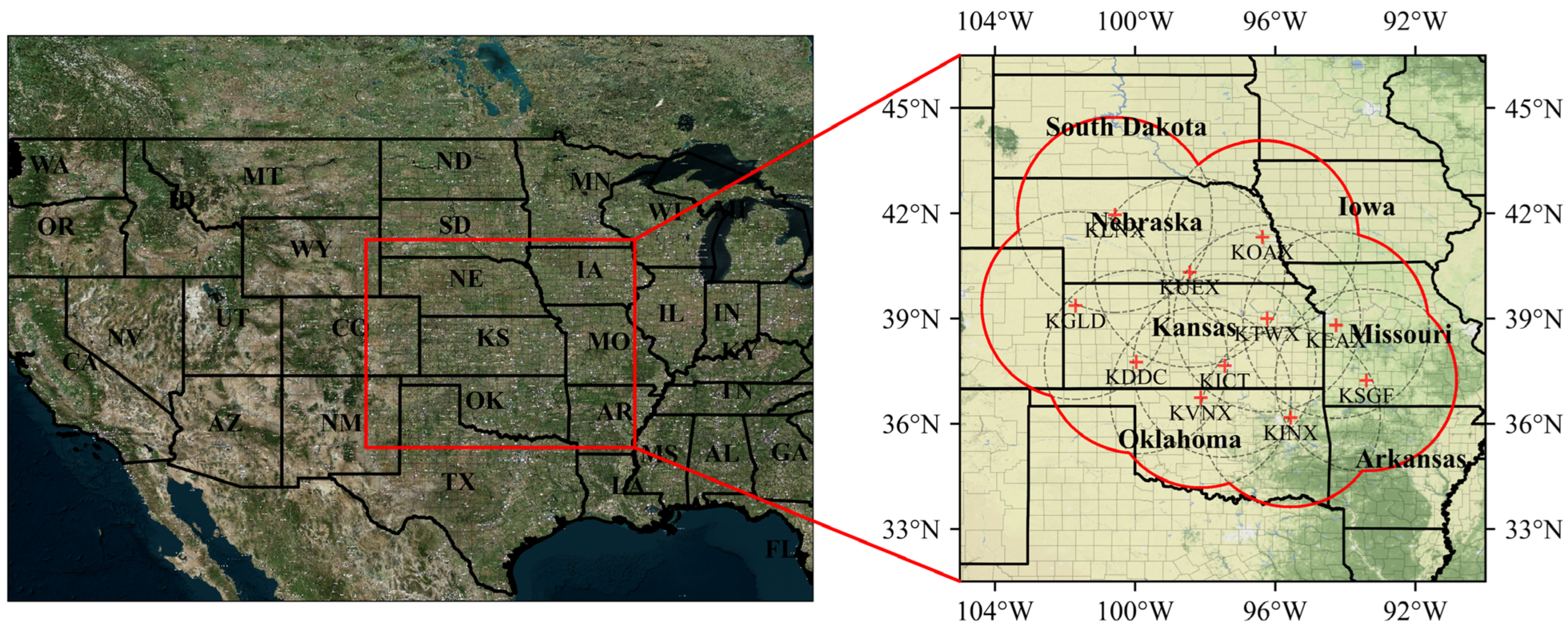
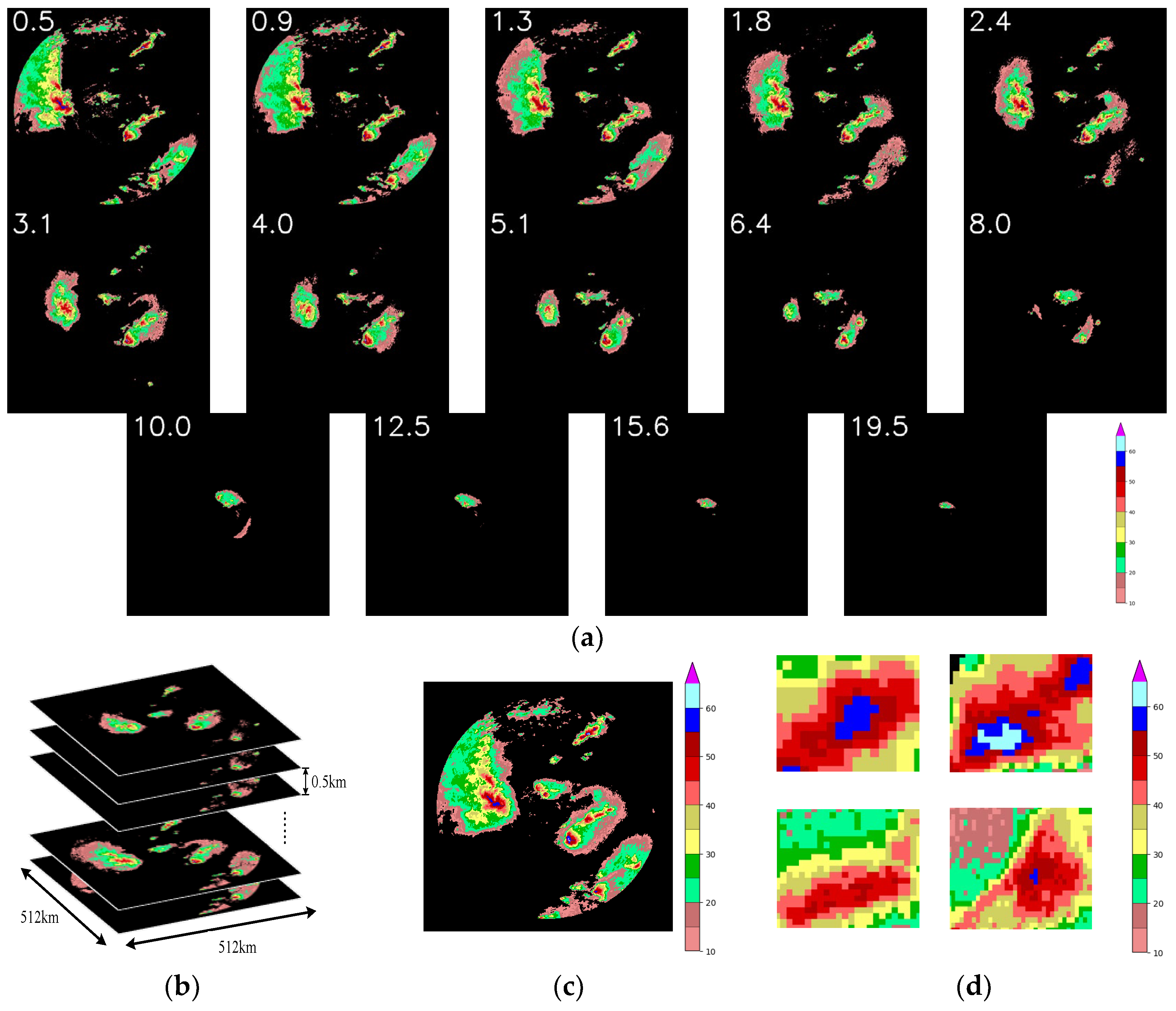
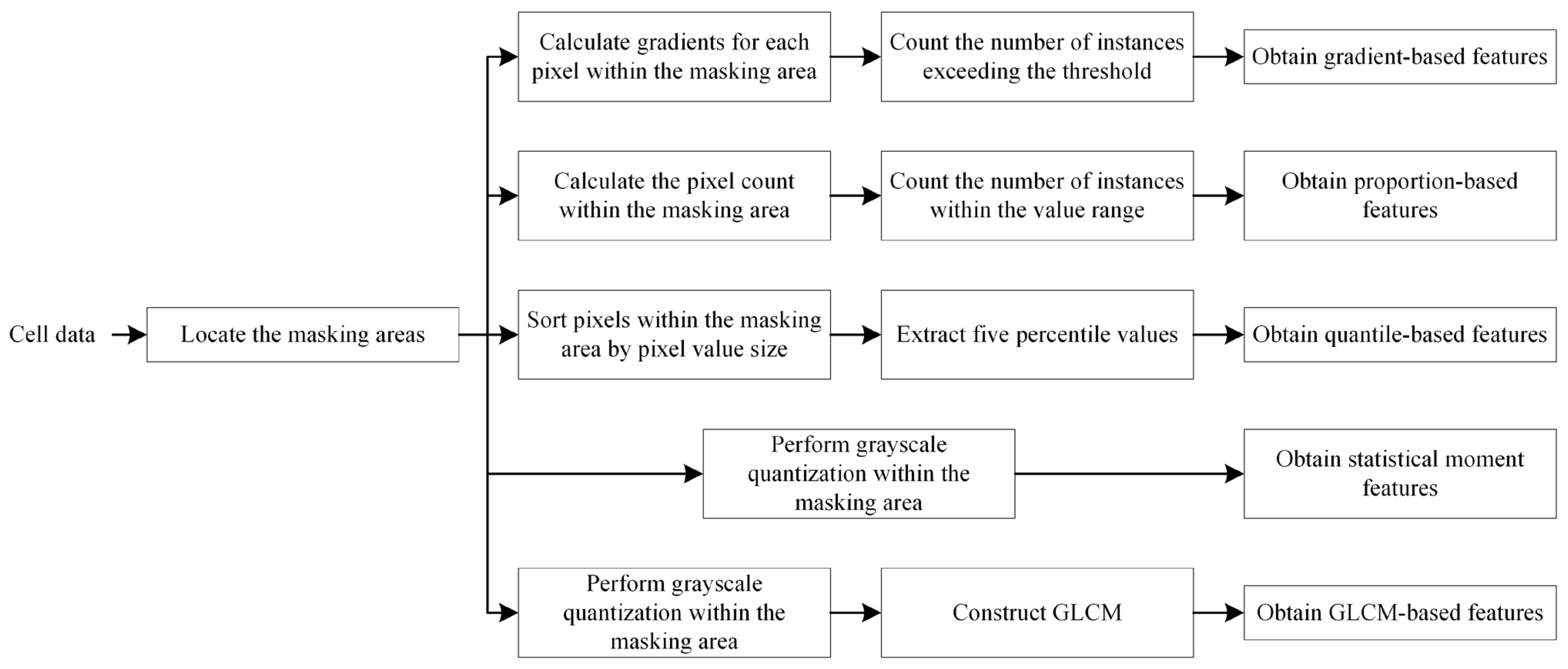
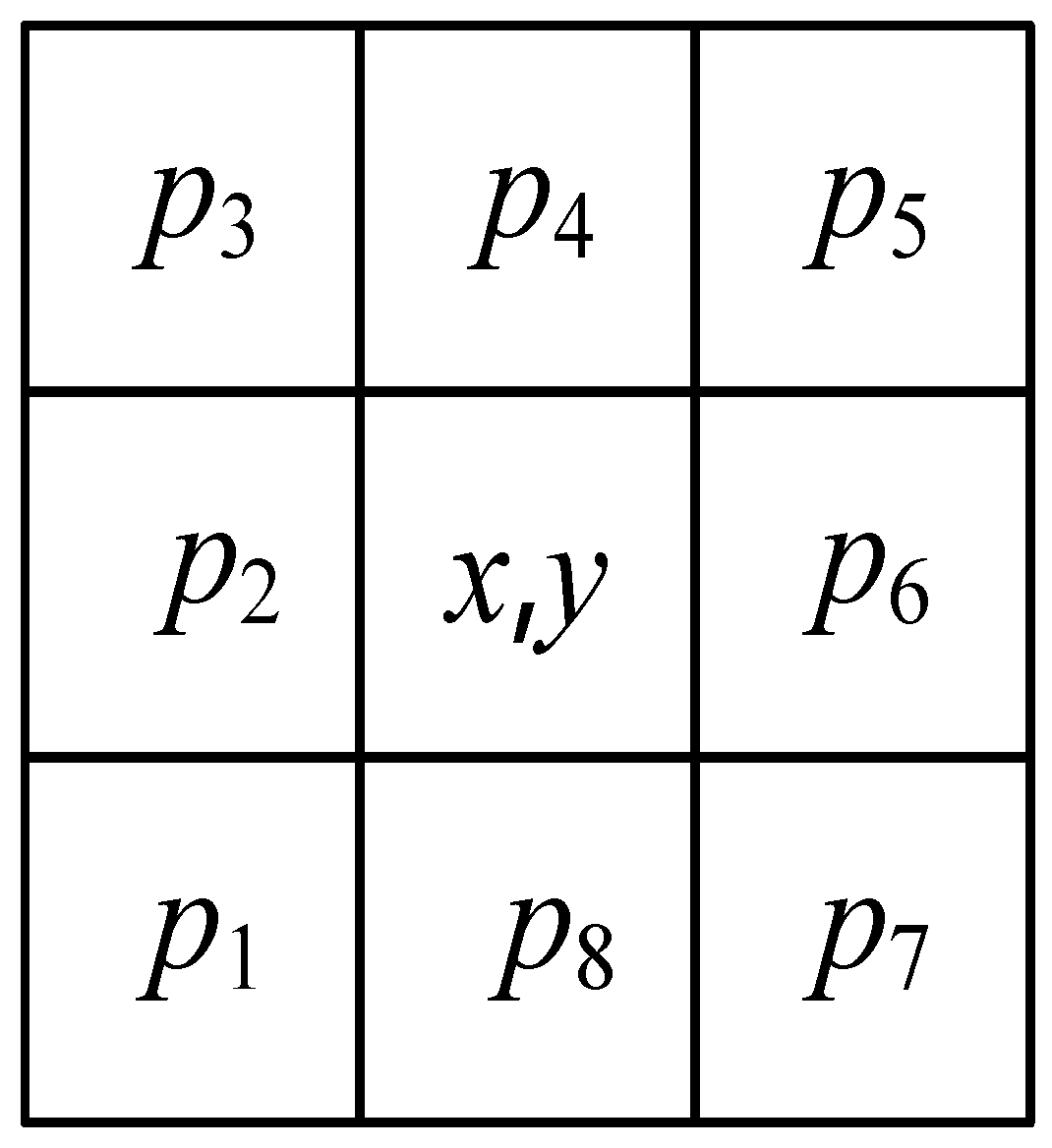
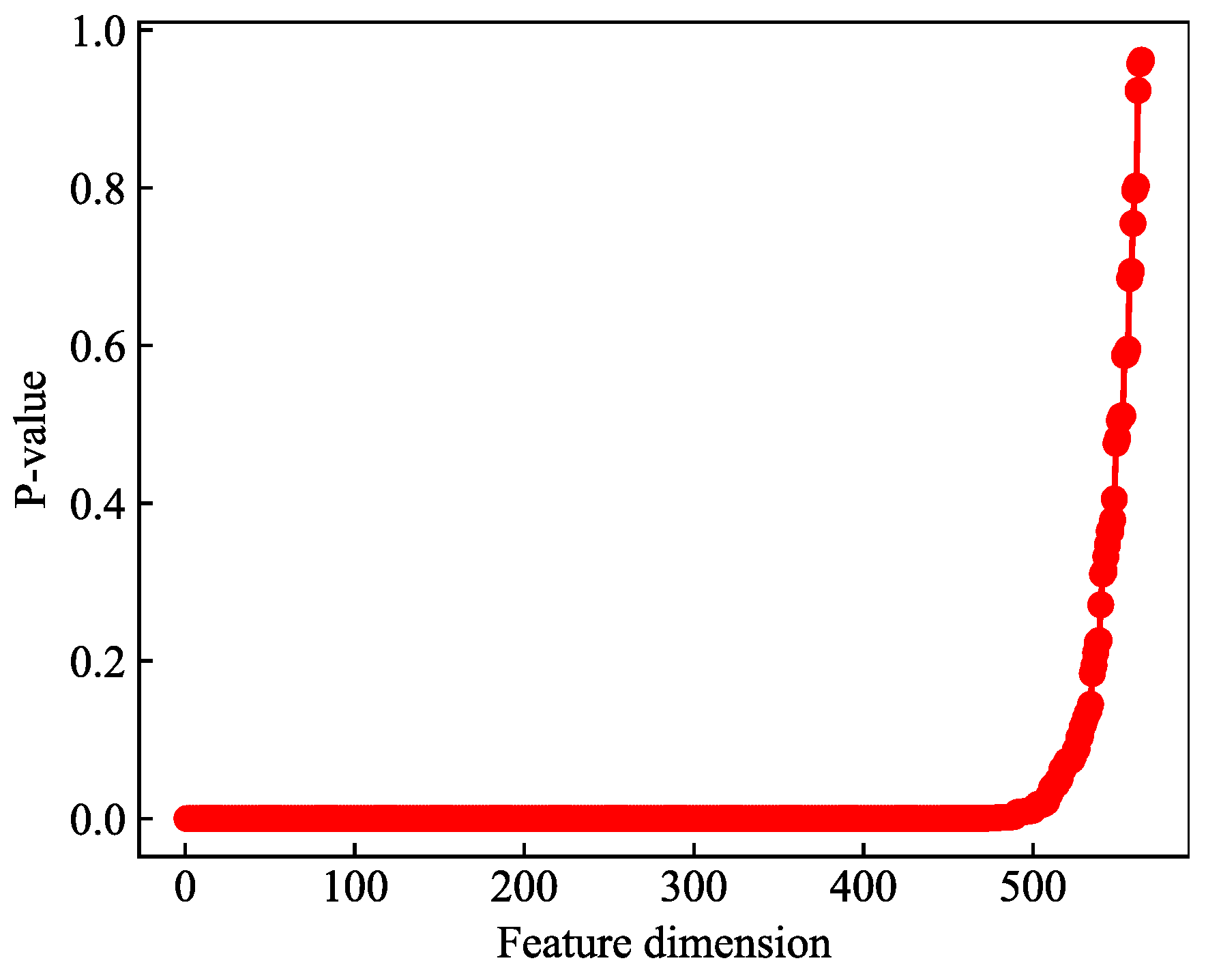
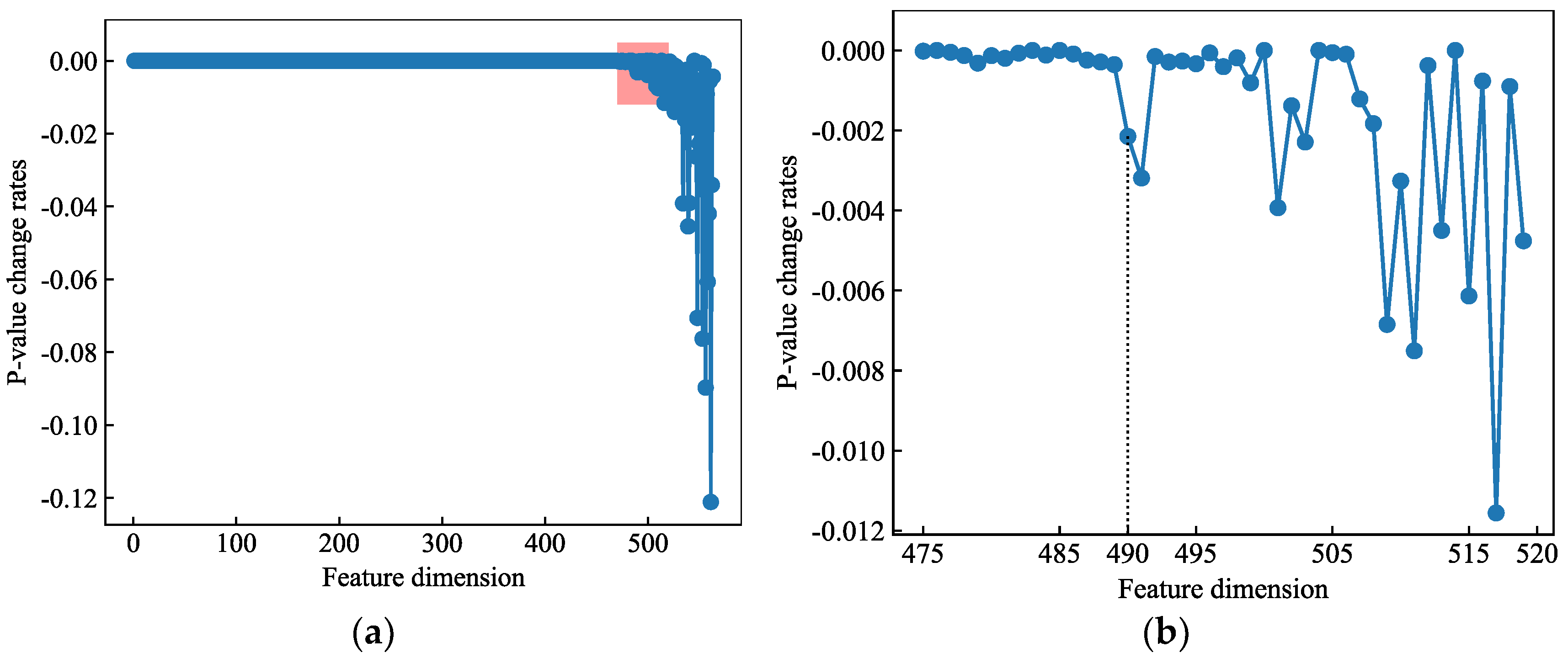


| Data Type | Mask (M) | Gradient Threshold (th) | Number of Microfeatures | Dimensions of Gradient-Based Feature |
|---|---|---|---|---|
| CR | Ω40 | 2, 3, 4 | 3 | 48 |
| ZH at 5 different heights | Ω40 | 2, 3, 4 | 3 × 5 | |
| ZDR at 5 different heights | Ω40, Ω50 | 1, 1.5, 2 | 3 × 5 × 2 |
| Feature Name | Calculation Formula |
|---|---|
| hi | ||||
|---|---|---|---|---|
| h1 | h2 | h3 | h4 | h5 |
| H0°C − 1 km | H0°C | H0°C + 1 km | H−20°C − 1 km | H−20°C |
| Data Type | Value Range (ω) | Mask | Feature Dimension 72 | |||
|---|---|---|---|---|---|---|
| CR | [45, ∞) | [55, ∞) | Ω40 | 2 | ||
| ZH at 5 heights | [45, ∞) | [55, ∞) | Ω40 | 2 × 5 = 10 | ||
| ZDR at 5 heights | [−0.5, 0.5] | [−1, 1] | [−1.5, 1.5] | Ω40, Ω50 | 5 × 3 × 2 = 30 | |
| ρhv at 5 heights | [0.85, 0.92] | [0.83, 0.94] | [0.8, 0.97] | Ω40, Ω50 | 5 × 3 × 2 = 30 | |
| Feature Name | Calculation Formula |
|---|---|
| Data Type | Percentile (x%) | Mask | Feature Dimensions 140 |
|---|---|---|---|
| CR | 1%, 25%, 50%, 75%, 100% | Ω40 | 5 |
| ZH at 5 heights | 1%, 25%, 50%, 75%, 100% | Ω40 | 5 × 5 = 25 |
| ZDR at 5 heights | 1%, 25%, 50%, 75%, 100% | Ω40, Ω50 | 5 × 5 × 2 + 5 = 55 |
| ρhv at 5 heights | 1%, 25%, 50%, 75%, 100% | Ω40, Ω50 | 5 × 5 × 2 + 5 = 55 |
| x% | 1% | 25% | 50% | 75% | 100% |
|---|---|---|---|---|---|
| Meaning | Minimum value | Low quartile point | Median | High quartile point | Maximum value |
| Data Type | Gray Level L and Data Range | |||||||
|---|---|---|---|---|---|---|---|---|
| l = 0 | l = 1 | l = 2 | l = 3 | l = 4 | l = 5 | l = 6 | l = 7 | |
| CR | [34, 40) | [40, 45) | [45, 50) | [50, 55) | [55, 60) | [60, 65) | ≥65 | |
| ZH at 5 heights | ||||||||
| ZDR at 5 heights | [−3, −2) | [−2, −1) | [−1, 0) | [0, 1) | [1, 2) | [2, 3) | [3, 4) | ≥4 |
| ρhv at 5 heights | [0.4, 0.5) | [0.5, 0.6) | [0.6, 0.7) | [0.7, 0.8) | [0.8, 0.9) | ≥0.9 | ||
| Data Type | Mask | Feature Dimensions 48 |
|---|---|---|
| CR | Ω40 | 3 |
| ZH at 5 heights | Ω40 | 5 × 3 = 15 |
| ZDR at 5 heights | Ω40 | 5 × 3 = 15 |
| ρhv at 5 heights | Ω40 | 5 × 3 = 15 |
| Type | Feature Dimensions | |
|---|---|---|
| Gradient-based features | 48 | 564 |
| Proportion-based features in a specified value range | 72 | |
| Quantile-based intensity features | 140 | |
| Statistical moment features based on the gray-level histogram | 48 | |
| Features based on the GLCM | 256 | |
| Feature Type | Data Type | Proportion | ||||||||
|---|---|---|---|---|---|---|---|---|---|---|
| ZH | ZDR | ρhv | CR | H0–1 | H0 | H0+1 | H–20 | H–20–1 | ||
| Proportion-based | 0 | 0 | 11 | 0 | 4 | 5 | 2 | 0 | 0 | 11/72 |
| Quantile-based | 1 | 18 | 18 | 0 | 0 | 13 | 10 | 8 | 6 | 37/140 |
| Statistical moments | 4 | 1 | 3 | 0 | 1 | 2 | 1 | 2 | 2 | 8/48 |
| GLCM | 6 | 8 | 4 | 0 | 2 | 1 | 2 | 7 | 6 | 18/256 |
| Model | ZH Feature | ZDR Column | POD | FAR | CSI |
|---|---|---|---|---|---|
| 1 | √ | 0.804 | 0.290 | 0.605 | |
| 2 | √ | √ | 0.820 | 0.286 | 0.617 |
| Model | Feature | POD | FAR | CSI |
|---|---|---|---|---|
| 3 | 490-dimensional mechanism features | 0.701 | 0.193 | 0.600 |
| Model | Comprehensive Feature | POD | FAR | CSI |
|---|---|---|---|---|
| 4 | 5 first principal components | 0.796 | 0.316 | 0.582 |
| 5 | 5 first principal components + 5 s principal components | 0.799 | 0.279 | 0.610 |
| 6 | 5 Fisher | 0.867 | 0.278 | 0.650 |
| Model | Sample Description Method | POD | FAR | CSI |
|---|---|---|---|---|
| 1 | 8-dimensional traditional mechanism features | 0.820 | 0.286 | 0.617 |
| 2 | 5-dimensional Fisher-comprehensive features | 0.867 | 0.278 | 0.650 |
| 3 | 8-dimensional traditional mechanism features +5-dimensional Fisher-comprehensive features | 0.865 | 0.275 | 0.651 |
Disclaimer/Publisher’s Note: The statements, opinions and data contained in all publications are solely those of the individual author(s) and contributor(s) and not of MDPI and/or the editor(s). MDPI and/or the editor(s) disclaim responsibility for any injury to people or property resulting from any ideas, methods, instructions or products referred to in the content. |
© 2023 by the authors. Licensee MDPI, Basel, Switzerland. This article is an open access article distributed under the terms and conditions of the Creative Commons Attribution (CC BY) license (https://creativecommons.org/licenses/by/4.0/).
Share and Cite
Li, N.; Zhang, J.; Wang, D.; Wang, P. Research on Hail Mechanism Features Based on Dual-Polarization Radar Data. Atmosphere 2023, 14, 1827. https://doi.org/10.3390/atmos14121827
Li N, Zhang J, Wang D, Wang P. Research on Hail Mechanism Features Based on Dual-Polarization Radar Data. Atmosphere. 2023; 14(12):1827. https://doi.org/10.3390/atmos14121827
Chicago/Turabian StyleLi, Na, Jun Zhang, Di Wang, and Ping Wang. 2023. "Research on Hail Mechanism Features Based on Dual-Polarization Radar Data" Atmosphere 14, no. 12: 1827. https://doi.org/10.3390/atmos14121827






